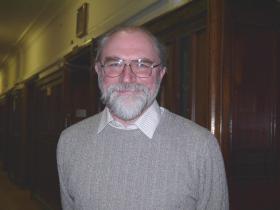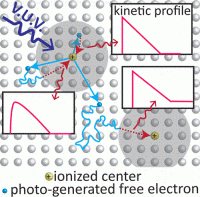
Leading researcher, the Head of the Department of Physical Problems of QUantum Electronics SINP, DSc. Andrey Vasil'ev
A paper by the scientists of the Laboratory of synchrotronous emission and solid state spectroscopy of the Department of the Physical Problems of Quantum ELectronics SINP together with the colleagues from the Institute of Light and Matter of the University Lion-1 (France) is publshed in «The Journal of Physical Chemistry Letters» (impact-factor of 6.585). In the paper named "Estimation of the Electron Thermalization Length in Ionic Materials" the authors proposed a new method for determination of the electron length in ionic materials during thermalization. The Leading researcher, the Head of the Department of the Physical Problems of Quantum Electronics SINP DSc. Andrey Vasil'ev told us about the details of this study.
- Andrey, please, tell us about the experiment.
- The experiment was conducted in DESY - the German Center for synchrotronous research - at SUPERLUMI station - a unique facility for the studies of luminescence during vacuum UV excitation.
How the experimnet was performed? In theelectron storage ring the electrons are accelerated up to very high energy. In the bending magnets under the influence of magnetic field they emit photons within the wide energy ranges - from IR to hard X-ray. At the SUPERLUMI station they use vacuum UV range absorbed by almost all substances. Therefore the experiment is performed under high vacuum conditions. Synchrotronous emission photos pass monochromator and are incident on the sample. In our case we had a ionic crystal of LiYF4 with admixture of trivalent cerium. Under the influence of the photons cerium is ionized. Detecting equipment measures luminescence decay kinetiсs for cerium which is determined by the processes of electrons' returning to the cerium ion.
Now we'll discuss a process which happens inside the ionic crystal. Primary photon can pass through the crystal but also can come to the ions of trivalent cerium - a specially added admixtures.  In this case the primary photon is absorbed by the cerium ion which is ionized. During ionization cerium ion becomes four-valent due to electron's passing from the ion to the conduction band. Kinetic energy of the electron is determined by the energy of the primary photon. This energy varies up to several electron-volts (eV), i.e. much more than thermal energy value equal to 0.025 eV at the room temperature. Such electron comes off the four-valent cerium ion and loses its energy during interaction with crystal lattice vibrations. The distance at which the electron flying away is thermalization length. The the electron can be attracted the cerium ion.
In this case the primary photon is absorbed by the cerium ion which is ionized. During ionization cerium ion becomes four-valent due to electron's passing from the ion to the conduction band. Kinetic energy of the electron is determined by the energy of the primary photon. This energy varies up to several electron-volts (eV), i.e. much more than thermal energy value equal to 0.025 eV at the room temperature. Such electron comes off the four-valent cerium ion and loses its energy during interaction with crystal lattice vibrations. The distance at which the electron flying away is thermalization length. The the electron can be attracted the cerium ion.
- Why electron is attracted to the four-valent cerium ion?
- Cerium ion can attract the electron back due to its effective positive charge. Concerning the character of the motion, in ionic crystals thermal electron's length is small and its motion is diffusion in the Coulomb field of the ion. The probability that the electron will return to the cerium ion from which he came off is higher, if it is located from the ion at the distances less than so-called Onsager radius. At this radius potential energy is equal to thermal energy. Theoretically this phenomenon was developed in 1930s. For our matter Onsager radius at room temperature is about 7 nanometers.
- What happens to the four-valent cerium ion when the electron returs?
- Returned electron will change cerium ion state from four-valent to tri-valent and simultaneously excite it. Then excited tri-valent cerium ion will emit luminescence photon which can be detected by the system. The luminescence is buildup during the electon's diffusion to the ion.
In our study we have shown that the profile and duration of luminescence provide an opportunity for calculations of the distance to which the electron will fly. In other words - to answer the question what will be the electron thermalization length.
- What the distance of the electron's flyoff depends on?
- Electon thermalization length depends on the pimary energy of the electron. If it has high primary energy, than it will fly to the longer distance. Dependence of the distance on the energy is not linear: distance is determined by efficiency of the eelctron's interaction with the crystal lattice vibrations, which in turn depends on the kinetic energy of the electron.
The results of our analysis have shown good agreement between the experimental data on the dependence of thermalization length on the electron's kinetic energy and theoretical predictions.
We have also shown that the initial position of the electron provides a possibility to estimate the probability: will it be captured at once or after some time, or it will pass and will not retur to the ion which produced it. It can go toanother cerium ion, there are a lot of them in the crystal.
- What is your contribution to this study?
- I developed theoretical models and programs for calculation of the model parameters basing on experimental data.
- What are possible applications of the results of your research?
- How it can be used? What for we need to know thermalization length? Here it is necessary to turn to the problem of scintillators, because there electrons with different kinetic energies are also produced. But there the electrons are excited not by the external photon, as in our study, but by the electric field of the ionizing particle. In the scintillator the fast particle passing through the crystal produces a lot of secondary electrons and electron holes by its electric field. ELectrons with different kinetic energies fly to different distances, forming track's geometry. This structure will determine efficiency of electrons and holes recombination and efficiency and other characteristics of scintillator.
In particular, energy resolution of scintillator will depend on track's structure. High energy resolution is needed, for instance, for estimation of radioactive isotope, which emitted the particle. Scintillators with very high energy resolution are used in radiation monitoring systems, where it is necessary to separate gammas slightly different in energy. These scintillators'detectors can beused, for instance, in the doorways for cargo monitoring onboard carrier vehicles - in order to show if there are fissile materials inside.
Up-to-date scintillators with top characteristics are also needed for the purposes of high-energy physics. They are also used in medicine, for instance, for computer tomography or positron-emission tomography for tumor diagnostics.
Besides, concept of relations between the track's structure and scintillator's parameters is fruitfull for engineering purposes in the field of new scintillation materials development. In our Laboratory we studied and explained the behaviour of new scintillators - not pure crystals, but solid-state solutions basing on the method of thermalization length studies. It was a joint research with Dmitry Spassky, our colleagues from the Physics Department of MSU and a number of the Laboratories from Kharkov (Ukraine) and Lion (France). It was found out that for a number of solid solutions scintillator output is higher than for pure crystals. The reason is that thermalization length in solid solutions is shorter.
- And the last question - what are your plans in this direction?
- Our research is a brick in general mechanism, total model, which describes the processes in scintillation crystals; so, we'll continue "manufacturing other bricks", i.e. we'll continue our studies.
